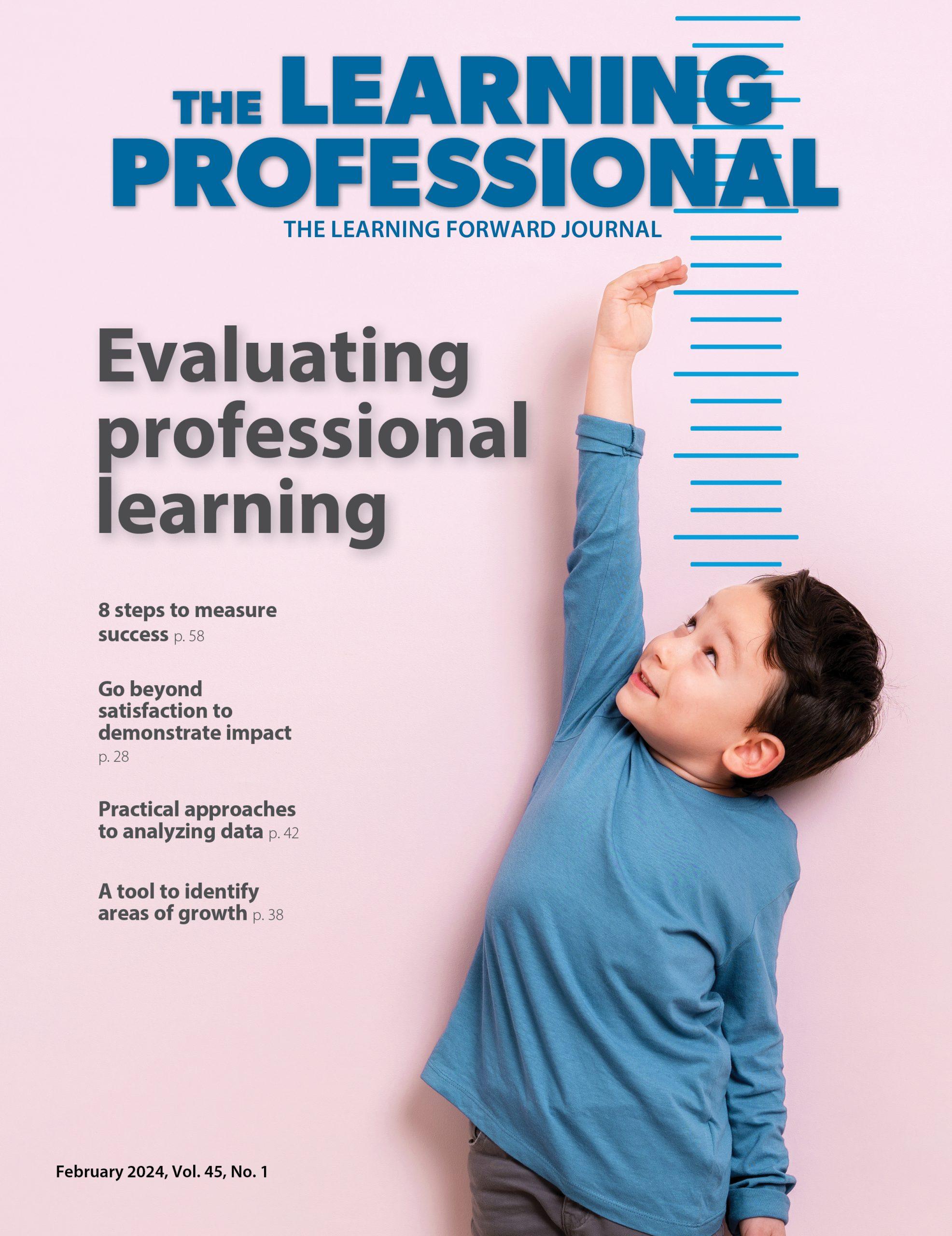Lessons From Research
Professional learning’s spillover effect is real — and a real opportunity for school and system leaders
By Learning Forward
February 2014
What the Study Says
The benefits of teacher collaboration within and across schools are well-known. Researchers of this study provide empirical evidence about the benefits of teacher interaction as a mechanism to diffuse the effects of professional development (the term used throughout this study) to improve instructional practices.
Study description
This study examined the knowledge flow and spillover effects of teachers’ professional development on their peers’ instructional practices in writing across multiple disciplines. The current study used data from three school years, 2007-10, which were part of a larger longitudinal evaluation study of the National Writing Project’s school partnership.
In the larger study, data were derived from teachers, who had limited or no prior experience with Local Writing Project sites, in 39 middle schools serving 7th- and 8th-grade students. The schools were randomly assigned to partnership (treatment) or delayed partnership (control) cohorts.
Teachers across subject areas in 20 partnership schools participated in customized professional development provided by their Local Writing Project over two years. Nineteen schools, with features comparable in school contexts and teacher characteristics to the control schools, became delayed partnership schools and agreed to defer schoolwide professional development in writing for the subsequent two years except for state or district requirements.
Researchers, building on prior studies of peer effects, impact of professional development, social networks, and knowledge diffusion, studied the effects of professional development on peers’ instructional practice.
Few studies have examined the spillover effect of high-quality professional development in content areas and on peer instructional practices. Spillover effect is defined as “the effects of school-based professional development on instructional practices above and beyond the direct effects on teachers who participated in professional development” (p. 345).
Through interactions with colleagues who participate in effective professional development, teachers who do not participate directly benefit and consequently change their instructional practices.
Questions and hypotheses
Researchers posed two questions and corresponding hypotheses:
“1. How do the duration, content foci, and learning strategies of professional development affect the number of colleagues a teacher helps with teaching writing? …
“Hypothesis 1: Teachers are more likely to provide help with writing instruction if they participated in high-quality professional development. …
“2. How do teachers’ changes in their instructional practices result from interacting with colleagues who had gained expertise from their prior professional development? …
“Hypothesis 2: The expertise that teachers gain from participation in professional development will spread to colleagues through the provision of help and thus change colleagues’ instructional practices” (pp. 347-348).
Methodology
The study’s methodology included three annual surveys of certified staff in each school in the spring semester of Year 1 (baseline year), Year 2 (first year of professional development), and Year 3 (second year of professional development), with an average response rate above 90% across all three years and all schools.
Standard deviations for school contexts, including student achievement as defined by meeting Adequate Yearly Progress, and teacher characteristics across partnership and delayed partnership schools were comparable.
Analysis
Researchers employed separate statistical analyses with mathematical modeling to examine the relationship between dependent and independent variables at the teacher level in the partnership and delayed partnership schools to isolate effects since there were wide variations in professional development across partnership schools and some delayed partnership schools experienced professional development with similar features to those in the partnership schools.
Dependent variables included:
- Number of teacher colleagues helped with writing in Year 3;
- Writing instruction in Year 3 as measured by teachers’ self-report of frequency of use of research-based instructional practices in writing;
- Breadth of purposes of student writing; and
- Frequency of student engagement in writing-related activities.
Independent variables included these features of research-based professional development:
- Duration of professional development in Year 3;
- Breadth of content focus on knowledge, skills, and strategies in writing instruction;
- Breadth of active learning strategies used in professional development; and
- Exposure to expertise of colleagues who participated in Year 2 professional development.
Researchers developed multiple mathematical measures to analyze effects. One measure was based on the assumption that change in the number of colleagues helped between Years 2 and 3 was a result of expertise the helping teacher gained from professional development in Year 3.
A second measure calculated how professional development and collegial interactions shaped instructional practices. This measure, based on social network influence, measured how the knowledge and strategies participants in Year 2 professional development spread to peers as determined by the changes in instructional practices of the peers.
Results
Key findings of this study include:
- Teachers who participated in professional development of greater duration, with broader range of content foci on writing instruction and with a larger number of active learning strategies, were more likely to provide help to colleagues with teaching writing. They developed more expertise and confidence in practice and became go-to experts for peers and used the active learning strategies to help peers.
- Peers’ interactions with colleagues who experienced intensive professional development in Year 2 had a significantly positive effect on their own instructional practices in writing in Year 3 in both treatment and control schools. Through collegial interactions, expertise spread among teachers.
- The effect of exposure to colleagues’ breadth of writing instruction content on writing instructional practices nearly equals the effect of direct exposure to the breadth of content in writing instruction on writing instructional practices, signaling a noteworthy finding for the design and spillover effect of professional development. Improvements in instructional practices of teachers who did not participate in professional development increased almost as much as those of teachers who participated directly in professional development.
Limitations
Researchers note a number of limitations. A single data set — the teacher survey — was used for the study. The unit of randomization in the longitudinal study whose data were used for this study is the school, yet the unit of analysis in this study is the individual teacher.
Only three features of professional development were analyzed: duration, content area focus, and active learning. Other features not analyzed might affect the positive spillover effects.
The study focused on teachers across multiple disciplines rather than subgroups of teachers. It is possible English language arts teachers may be impacted differently than teachers of other disciplines. Researchers acknowledge potential measurement errors.
Finally, this study does not examine the impact of changes in instructional practices on student achievement. The authors advocate that future research addresses these limitations.
Implications
Researchers cite a number of policy implications that emerge from this study, including the design of professional development. Schoolwide instructional improvement results from professional development with extended duration, content focus, and active learning strategies and intentionally distributing teachers with expertise in content, pedagogy, and collaboration within the school.
Incorporating into professional development strategies to increase teacher collaboration to extend the diffusion of expertise may build the capacity of teachers to serve as internal experts who are available to provide assistance to their colleagues.
At a Glance
This study provides empirical evidence that effective professional development has a positive significant impact on instructional practices not only for those who directly experience professional development, but also for colleagues who receive help and support from those who have participated directly and thus gained expertise.
The Study
Sun, M., Penuel, W.R., Frank, K.A., Gallagher, H.R., & Youngs, P. (2013, April). Shaping professional development to promote the diffusion of instructional expertise among teachers. Educational Evaluation and Policy Analysis, 35(3), 344-369.
What This Means for Practitioners
So how do we use this study to influence our practice? This study provides empirical evidence of the spillover effect and focused on specific attributes of effective professional learning.
When planning, implementing, and evaluating professional learning, leaders must use research-based features, including the three features examined in this study. These features, as well as additional ones drawn from a consensus of research and evidence-based practice, are delineated in the Standards for Professional Learning and guide the design and continuous assessment and evaluation for effective implementation.
With evidence that spillover effect is nearly equal to the effects of direct participation, leaders within schools and those within school systems must leverage this information to distribute expertise among staff by thoughtfully selecting and purposely building the capacity of staff within the school to increase the diffusion of expertise. Schools may benefit from multiple experts rather than a single expert such as an instructional coach.
Leveraging the spillover effect may mean that existing content experts within the school may need to develop more capacity to collaborate with colleagues or that leaders should develop stronger content expertise in teachers who have strong relationship and collaboration skills.
For the kind of interactions that produce the spillover effects described in this study to occur, state, district, and school leaders must adjust school day schedules and school year calendars to provide time for collaboration about content-specific instruction.
Teacher collaboration about instruction, particularly writing instruction as a tool for learning in all disciplines, has the potential to lead to increased student success in all discipline areas in which teachers integrate writing for multiple purposes.
However, the ultimate outcome of improved student learning is not magic. It requires that all teachers commit to developing and sharing expertise widely across the school. In such a culture of growth and development and collective responsibility, all students will thrive.
Learning Forward is the only professional association devoted exclusively to those who work in educator professional development. We help our members plan, implement, and measure high-quality professional learning so they can achieve success with their systems, schools, and students.
Recent Issues
LEARNING TO PIVOT
August 2024
Sometimes new information and situations call for major change. This issue...
GLOBAL PERSPECTIVES
June 2024
What does professional learning look like around the world? This issue...
WHERE TECHNOLOGY CAN TAKE US
April 2024
Technology is both a topic and a tool for professional learning. This...
EVALUATING PROFESSIONAL LEARNING
February 2024
How do you know your professional learning is working? This issue digs...








